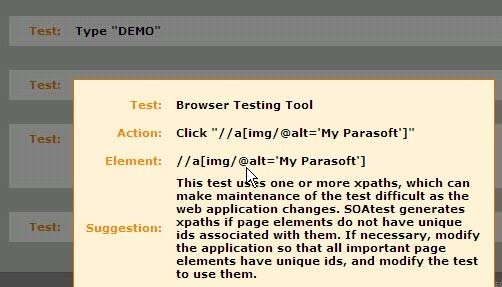This topic explains the purpose of SOAtest’s Test Maintainability report, and describes how to access it.
Sections include:
Understanding the Test Maintainability Report
How element locators get created is one of the greatest barriers to creating maintainable web scenarios that withstand changes to a web application over time. If page elements are created with unique attributes such as an id, then a test can be generated that uses that id to locate the element. No matter where the element moves on the page, the element will be able to be located because the id is unique. However, these kinds of unique identifiers are not often used in web applications. XPaths are commonly used instead, but tests that use XPaths are difficult to maintain. Why? If page elements get rearranged, the XPaths quickly can become invalid.
To help you gauge the maintainability of a test suite, SOAtest provides a Test Maintainability report that shows a summary of web scenarios. A warning is generated for each test with low maintainability—in other words, a test that uses one or more XPaths, which can make test maintenance difficult as the web application evolves.
Clicking on a warning opens a dialog that provides more detail.
Generating a Test Maintainability Report
A Test Maintainability report can be generated in two ways:
- Right click on a root .tst file in the Test Case Explorer, then choose View Test Maintainability Report from the shortcut menu.
- When creating a new web scenario from browser recording (as described in Browser Recording and Playback), select the Generate Test Maintainability Report check box in the browser recording wizard. The report will open automatically when the recording is completed.

